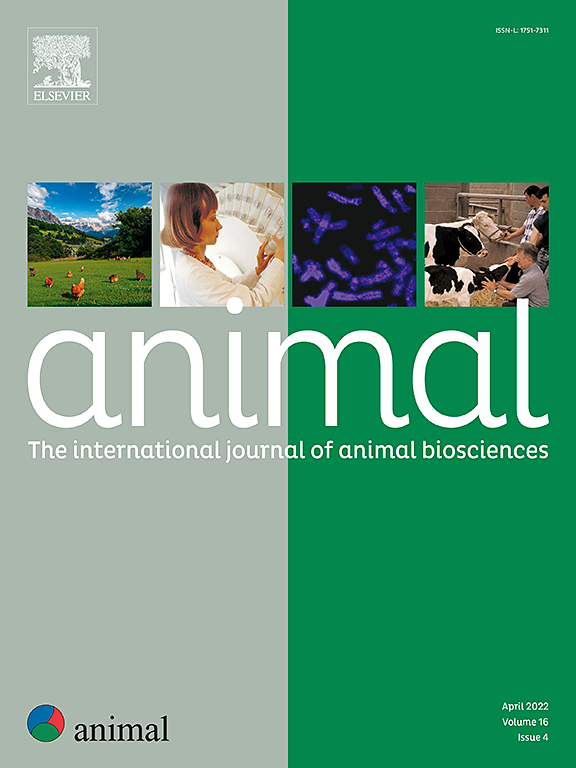Effects of oxygen levels and temperature on growth and physiology of pikeperch juveniles cultured in a recirculating aquaculture system
IF 4.2
2区 农林科学
Q1 AGRICULTURE, DAIRY & ANIMAL SCIENCE
引用次数: 0
Abstract
This study aimed to understand how environmental factors, specifically water temperature and oxygen saturation, affect the growth performance and physiology of pikeperch (Sander lucioperca) juveniles in recirculating aquaculture systems (RASs). Given the importance of optimising growth conditions in aquaculture to maximise efficiency, it aims to assess whether different combinations of oxygen levels and temperatures can enhance growth while maintaining the physiological health and welfare of the fish. The experimental design included the culturing pikeperch juveniles (22.7 ± 7.1 g) were exposed to hypoxia (78 ± 14%), normoxia (105 ± 12%), and hyperoxia (140 ± 18%) conditions for 72 days. This was conducted at two temperatures, 20 °C and 23 °C, each in a separate but identical RAS. The level of oxygen supply was controlled with micro bubble diffusers on the bottom of each tank. The hyperoxia at 23 °C positively affected total length, BW, specific growth rate, feed intake and feed conservation rate (FCR). The slowest growth and feed intake, along with the highest FCR, were observed in hypoxia at 20 °C. Fish reared under 23 °C exhibited significantly higher visceral-somatic index (3.54 ± 0.83 at 23 °C and 2.76 ± 0.73 at 20 °C) regardless of oxygen levels. It was primarily responsible for the observed growth difference (Final BW: 58.3 ± 18.8 g at 23 °C and 53.0 ± 18.3 g at 20 °C). The water temperature also affected haematocrit, haemoglobin, leucocyte count, mean corpuscular haemoglobin, mean corpuscular volume (MCV) of the blood cells; the concentration of lymphocytes, neutrophile granulocyte bands and segments. Among biochemical markers, temperature affected cytoplasmic and mitochondrial enzymes, ammonia and triglyceride levels in blood plasma. Elevated antioxidant activity was observed in muscle, intestine and liver tissues. Oxygen levels demonstrated significant effects on growth, feed intake and conversion, the MCV of the blood cells, the concentration of the glucose, lactate and ammonia in blood plasma, and antioxidant biomarkers in the liver tissue. The analysis indicated a significant effect of oxygen on energy metabolism. The results showed hyperoxia under 23 °C create conditions for the highest growth and feed intake, high feed utilisation. There are, however, concerns about the physiological conditions and welfare of intensively cultured pikeperch juveniles, as higher feed intake led to increased visceral fat content in the body, elevated antioxidant activity in the liver, muscle and intestine tissues, morphology of blood cell, and energy metabolism.
氧气水平和温度对循环水产养殖系统中养殖的梭子鱼幼鱼的生长和生理的影响。
本研究旨在了解环境因素(特别是水温和氧气饱和度)如何影响梭子鱼(Sander lucioperca)幼鱼在循环水养殖系统(RAS)中的生长表现和生理机能。鉴于在水产养殖中优化生长条件以实现效益最大化的重要性,本研究旨在评估不同的氧气水平和温度组合是否能在保持鱼类生理健康和福利的同时促进其生长。实验设计包括将养殖的梭子鱼幼鱼(22.7 ± 7.1 克)置于缺氧(78 ± 14%)、常氧(105 ± 12%)和高氧(140 ± 18%)条件下 72 天。试验在 20 °C 和 23 °C 两种温度下进行,每种温度都在一个单独但相同的 RAS 中进行。氧气供应水平由每个水槽底部的微气泡扩散器控制。23 °C的高氧对总长度、体重、特定生长率、摄食量和饲料保存率(FCR)均有积极影响。在 20 °C的低氧条件下,鱼的生长速度和摄食量最慢,FCR 最高。在 23 °C条件下饲养的鱼类,无论氧气水平如何,内脏-感觉指数都明显较高(23 °C时为3.54 ± 0.83,20 °C时为2.76 ± 0.73)。这也是观察到的生长差异的主要原因(最终体重:23 °C时为58.3 ± 18.8克,20 °C时为53.0 ± 18.3克)。水温还影响血细胞比容、血红蛋白、白细胞计数、平均体细胞血红蛋白、血细胞平均体液容积(MCV)、淋巴细胞浓度、嗜中性粒细胞条带和片段。在生化指标中,温度影响血浆中的细胞质酶和线粒体酶、氨和甘油三酯水平。在肌肉、肠道和肝脏组织中观察到抗氧化活性升高。氧气水平对生长、采食量和转化率、血细胞的 MCV、血浆中葡萄糖、乳酸盐和氨的浓度以及肝组织中的抗氧化生物标志物都有显著影响。分析表明,氧气对能量代谢有显著影响。研究结果表明,23 °C下的高氧条件可为最高的生长速度和采食量、高饲料利用率创造条件。然而,密集养殖的梭子鱼幼鱼的生理条件和福利令人担忧,因为较高的饲料摄入量会导致体内内脏脂肪含量增加,肝脏、肌肉和肠道组织中的抗氧化活性、血细胞形态和能量代谢升高。
本文章由计算机程序翻译,如有差异,请以英文原文为准。
求助全文
约1分钟内获得全文
求助全文
来源期刊

Animal
农林科学-奶制品与动物科学
CiteScore
7.50
自引率
2.80%
发文量
246
审稿时长
3 months
期刊介绍:
Editorial board
animal attracts the best research in animal biology and animal systems from across the spectrum of the agricultural, biomedical, and environmental sciences. It is the central element in an exciting collaboration between the British Society of Animal Science (BSAS), Institut National de la Recherche Agronomique (INRA) and the European Federation of Animal Science (EAAP) and represents a merging of three scientific journals: Animal Science; Animal Research; Reproduction, Nutrition, Development. animal publishes original cutting-edge research, ''hot'' topics and horizon-scanning reviews on animal-related aspects of the life sciences at the molecular, cellular, organ, whole animal and production system levels. The main subject areas include: breeding and genetics; nutrition; physiology and functional biology of systems; behaviour, health and welfare; farming systems, environmental impact and climate change; product quality, human health and well-being. Animal models and papers dealing with the integration of research between these topics and their impact on the environment and people are particularly welcome.
 求助内容:
求助内容: 应助结果提醒方式:
应助结果提醒方式:


